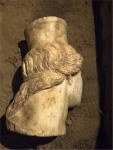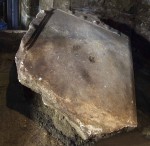 The hits just keep on coming at the Amphipolis tomb excavation. Archaeologists have crossed from the second chamber with the Persephone mosaic floor over the threshold into the third chamber. Lying just six inches on the other side of the marble threshold they found the decapitated head of one of the sphinxes that stands guard in the tomb’s entryway. There is some damage to the nose and lips, but otherwise the head is remarkably intact.
The hits just keep on coming at the Amphipolis tomb excavation. Archaeologists have crossed from the second chamber with the Persephone mosaic floor over the threshold into the third chamber. Lying just six inches on the other side of the marble threshold they found the decapitated head of one of the sphinxes that stands guard in the tomb’s entryway. There is some damage to the nose and lips, but otherwise the head is remarkably intact.
 The head is about 24 inches high and depicts the serene visage of a beautiful woman. Her hair is long and wavy, falling over the left shoulder and tied around the head with a white band. Traces of red paint are visible to the naked eye in her hair. She has a column or pillar on her head, a shorter version of the architectural support the caryatids in chamber two sport on their heads, that would have abutted the stone arch at the entry. It’s a tight fit. At a glance, I’m not entirely persuaded that the head really does fit the sphinx — if you look at a photomontage the proportions seem off — but it’s impossible to draw any conclusions from images alone, so I’ll defer to the archaeologists on the ground.
The head is about 24 inches high and depicts the serene visage of a beautiful woman. Her hair is long and wavy, falling over the left shoulder and tied around the head with a white band. Traces of red paint are visible to the naked eye in her hair. She has a column or pillar on her head, a shorter version of the architectural support the caryatids in chamber two sport on their heads, that would have abutted the stone arch at the entry. It’s a tight fit. At a glance, I’m not entirely persuaded that the head really does fit the sphinx — if you look at a photomontage the proportions seem off — but it’s impossible to draw any conclusions from images alone, so I’ll defer to the archaeologists on the ground.
 The entire neck is still there, including the join area where it was ostensibly broken off the sphinx’s body. It could match the breaking point on the trunk of the eastern sphinx. Additional fragments of the wings of the sphinxes were also discovered around the head. How these pieces got inside the tomb especially in such great condition is a mystery. It seems too preservative to be vandalism, and why would a looter bother to move a head and wing fragments to the comparative safety of the interior?
The entire neck is still there, including the join area where it was ostensibly broken off the sphinx’s body. It could match the breaking point on the trunk of the eastern sphinx. Additional fragments of the wings of the sphinxes were also discovered around the head. How these pieces got inside the tomb especially in such great condition is a mystery. It seems too preservative to be vandalism, and why would a looter bother to move a head and wing fragments to the comparative safety of the interior?

 Besides the head, archaeologists discovered the northern section of the marble threshold which is seven feet long and more than five wide. Dug into the marble are two deep curved depressions that experts believe once held metal rails that facilitated the movement of the heavy marble doors. The western wing of the door was also found, broken in two pieces. Limestone flooring is extant on both sides of the threshold. On the east side the wall intersecting with the floor appears to have collapsed. The west side of the floor has been damaged by falling blocks of limestone.
Besides the head, archaeologists discovered the northern section of the marble threshold which is seven feet long and more than five wide. Dug into the marble are two deep curved depressions that experts believe once held metal rails that facilitated the movement of the heavy marble doors. The western wing of the door was also found, broken in two pieces. Limestone flooring is extant on both sides of the threshold. On the east side the wall intersecting with the floor appears to have collapsed. The west side of the floor has been damaged by falling blocks of limestone.
Those blocks will be removed over the next few days, clearing the way for archaeologists to continue the excavation of the third chamber, shoring up the roof and walls as they go, as they head towards the entry to the fourth chamber.
